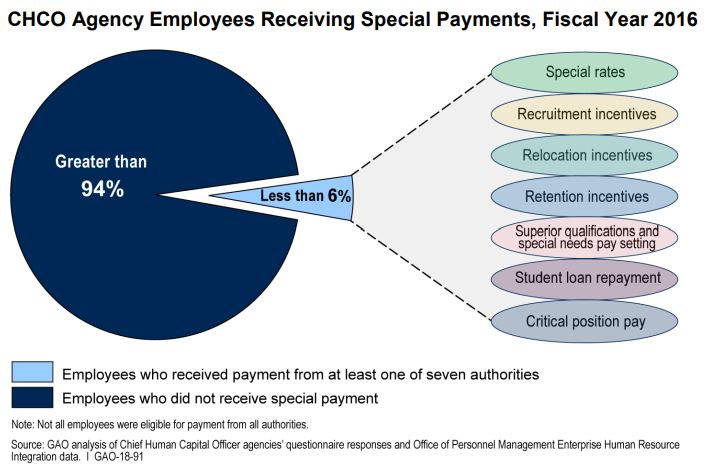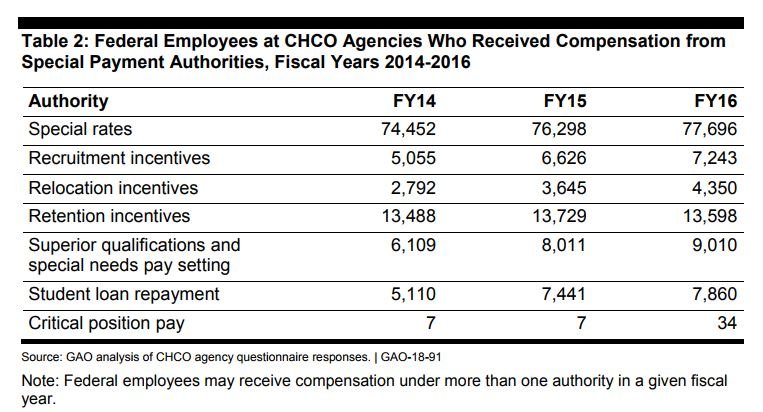
Despite having 7 ways to recruit, retain mission critical talent, agencies rarely use them
Agencies offered special payment authorities, such as retention incentives or student loan repayments, to less than 6 percent of the federal workforce between...
Agencies face increasing pressure to put the right people in the right jobs to tackle specific mission-critical priorities. And as budgets tighten and senior talent retires, human capital experts and even the Office of Personnel Management have encouraged agencies to get more creative to recruit and retain the best talent.
Agencies have a toolbox of seven different incentives and authorities they can use to attract and keep high-performing talent in mission critical positions. But according to a new study from the Government Accountability Office, agencies could use more help from OPM to use these authorities more expeditiously, and there’s little governmentwide analysis that details which incentives work best under certain circumstances.
Agencies have seven broad “special payment” authorities — special rates, recruitment incentives, relocation incentives, retention incentives, superior qualifications and special needs pay setting, student loan repayment and critical position pay — to help them compete for top talent and fill mission critical positions or skills gaps.
Less than 6 percent of more than 2 million federal employees in fiscal 2016 received special compensation under at least one of the seven special pay authorities, according to a GAO survey of 27 Chief Human Capital Officers agencies.

Most of these employees received special pay rates, followed by retention incentives. Few agencies used critical position pay authorities, in part, because that authority is capped at 800 positions governmentwide.
“An OPM official said that over time agencies have relied less on these special rates due to the introduction of locality pay,” GAO wrote. “For example, in its 2005 annual review of special rates, OPM reported that 14 special rates schedules would be terminated because higher locality rates applied at all steps of each covered grade.”

Agencies spent about $805 million in total on recruitment, retention and relocation incentives (3Rs), as well as student loan repayments, between fiscal 2014-16. Of the three, agencies spent the most — 40 percent — on retention incentives than any of the others.
Few agencies are using these incentives or authorities to attract a broad swath of employees. For example, 23 said they used recruitment incentives between 2014 and 2016, but 11 of those agencies said they used the authority for 10 employees or fewer per year.
Spending on the 3Rs, however, has risen since 2014, GAO said. OPM had put a freeze on spending for recruitment and retention incentives back in 2011 and removed the caps at the end of last year.
Special payment authorities generally had positive impacts on agencies’ staffing and retention needs, agencies told GAO. More organizations are using these authorities to staff cybersecurity and Science, Technology, Engineering and Math (STEM) positions than any other mission critical area.
For example, the Environmental Protection Agency used a retention incentive to successfully persuade a senior research scientist to stay. The Homeland Security Department developed “a unique retention incentive plan that focused on specialized certification for employees in” IT and cybersecurity positions, GAO said.
Most agencies, however, said they lacked sufficient resources to use special payment authorities more regularly and that budget constraints forced them to use these incentives only to fill the most critical vacancies.
Only a quarter of agencies said legislative changes would help them better use special pay incentives, GAO said.
More resources may help agencies use special pay authorities more effectively, but many departments said better training for managers would also help them better use these programs.
“HHS noted that budget restraints over the last several years have led to retirements and resignations among its more experienced HR staff,” GAO wrote. “This resulted in a loss of institutional knowledge on complex pay and leave authorities, including those affecting special payments. HHS officials said the loss of experienced HR staff diminishes the agency’s internal capacity to train remaining staff.”
OPM has provided some resources and tools that agency HR managers can use to learn more about special payment authorities. It also collects data on how agencies are using those incentives, but it doesn’t use that data to better understand which authorities work best and how organizations can improve, GAO said.
“By not tracking and analyzing data on the use of special payment authorities, OPM and the CHCO Council do not have the information they need to help determine what potential changes may be needed, and have limited assurance that special payment authorities are helping agencies meet their needs and achieve recruitment and retention goals,” GAO wrote.
OPM officials told GAO they believe individual agencies are in the best positions to evaluate what special payment authorities meet their staffing and retention needs, but departments aren’t performing those assessments, either, auditors said.
GAO recommended that OPM, along with CHCO Council, analyze whether the seven special authorities are meeting agencies’ recruitment and retention needs. OPM should also develop best practices for using each of the seven incentives.
Citing criticisms from other agencies, GAO also recommended OPM set written procedures for assessing special payment authority requests that require the agency’s approval.
According to GAO auditors, OPM took, on average, four to six months to approve agencies’ special rates and critical pay requests.
Copyright © 2025 Federal News Network. All rights reserved. This website is not intended for users located within the European Economic Area.
Nicole Ogrysko is a reporter for Federal News Network focusing on the federal workforce and federal pay and benefits.
Follow @nogryskoWFED





